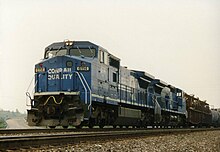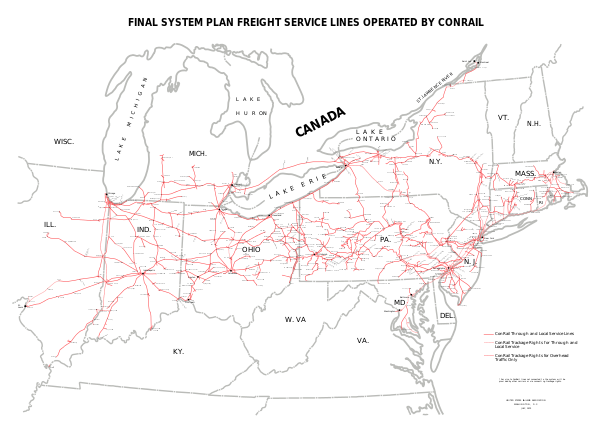Conrail

Conrail (short for Consolidated Rail Corporation , CR ) is a US railroad company based in Philadelphia . It was created in 1975 by the Railroad Revitalization and Regulatory Reform Act (4-R-Act) as a state-owned railway company under the name Consolidated Rail Corporation. After the takeover of Conrail by CSX Transportation and Norfolk Southern Railway in 1999, the joint activities of the two companies are bundled under the name “Conrail Shared Assets Operations” (CSAO).
history
1976-1999
With the bankruptcy of Penn Central and a few other railroad companies in the northeastern United States in 1970, there was a risk that an entire region would be cut off from the rail network. It was finally agreed to create a state rescue company that would take over the railway infrastructure and rolling stock from the bankrupt companies and operate them under its own control.
The infrastructure and traffic of the following bankrupt railway companies have been taken over:
- Central Railroad of New Jersey
- Erie Lackawanna Railroad
- Lehigh and Hudson River Railway
- Lehigh Valley Railroad
- Penn Central
- Reading Company
The company was founded in the summer of 1975; Operations began on April 1, 1976. In the following period, the network was optimized through closures and sales. In addition, the locomotive fleet was renewed. The ownership and operating rights to the Northeast Corridor route Washington-Boston were transferred to the semi-public long-distance operator Amtrak , which in turn handed over the New York - New Haven section to Metro North in 1983 . Amtrak also joined the electrified Philadelphia – Harrisburg route .
In 1981 the company was in the black for the first time. At the end of 1982 Conrail was allowed to part with its local transport services. In the Washington, DC / Baltimore area , this was taken over by MARC . The long-distance passenger transport company Amtrak was entrusted with the operational management. In the greater Philadelphia area , the regional transport company SEPTA took over the tasks in local transport.
In New Jersey, the activities of the NJ Transit traffic authority have been expanded to include the previous Conrail services.
In the states of New York and Connecticut , the Metro North Railroad, a subsidiary of the Metropolitan Transportation Authority (MTA), which operates the subways and buses and, since 1966, the Long Island Railroad (LIRR), took over the Conrail commuter service . In the Boston area, the MBTA was now responsible, which Amtrak also entrusted with operations. In 2003 Veolia took over the management.
In the mid-1980s, CSX Transportation and Norfolk wanted to buy Southern Conrail. But the unions and some of the shareholders of both companies did not come to an agreement. Congress decided to list Conrail on the stock exchange . The 1987 IPO was the largest in the United States to date at $ 1.9 billion .
In 1993 the holding company Conrail Inc. was founded, which acted as the parent company for the Consolidated Rail Corporation.
Due to its economic success, Conrail was again the target of a takeover battle between Norfolk Southern and CSX in the 1990s. In 1997 the two companies agreed to split Conrail on a 52 percent to 48 percent basis. This takeover took place on June 6, 1998. Conrail finally ended operations as an independent company on May 31, 1999.
Since 1999
However, the company is still active beyond this date. It initially serves under the name Conrail Shared Assets Operation (CSAO) Norfolk Southern and CSX Transportation as an operating and infrastructure company for freight traffic in the areas of Detroit and Philadelphia / Camden and Newark / North New Jersey in the north , which are served jointly by CSX and Norfolk Southern -East Corridor . Route networks in Detroit and Staten Island were added later.
Corporate management
- June 1975–1. January 1981: Edward G. Jordan , Chairman and CEO; until September 26, 1975 also president
- September 26, 1975-26. June 1978: Richard D. Spence , President
- February 14, 1979-31. December 1987: Stuart M. Reed , President
- January 1, 1981–1. January 1989: L. Stanley Crane , Chairman and CEO
- March 7, 1988-12. February 1989: Richard D. Sanborn , President, Chairman, President and CEO from January 1, 1989
- February 12, 1989-4. April 1989: Stanley EG Hillman , Chairman (acting)
- April 4, 1989-15. May 1996: James A. Hagen Chairman, President and CEO, President until September 1994, CEO until March 1995
- May 15, 1996-22. August 1998: David M. LeVan President since September 1994, CEO since March 1995 and Chairman since 1996
- August 22, 1998–1. February 2001: Tim O'Toole , President
- February 1, 2001–1. January 2004: Gregory R. Weber , President
- January 1, 2004 - 1. April 2017: Ronald L. Batory , President and COO
- from April 1, 2017: Timothy Tierney , President and COO
Individual evidence
- ^ Robert E. Bedingfield: Jordan Named the President of Conrail . In: The New York Times . June 21, 1975, p. 33 ( nytimes.com [accessed December 22, 2019]).
- ^ Rush Loving Jr .: The Men Who Loved Trains . Indiana University Press , 2006, ISBN 0-253-34757-2 , pp. 187 .
- ^ People and Business . In: The New York Times . September 27, 1975, p. 41 ( nytimes.com [accessed December 22, 2019]).
- ^ Company officials

